Swarovski 10×42 EL Laser Rangefinder Binoculars Review: A Hunter’s Dream or a Pricey Splurge? (Updated!)

I’m a bit of a gear junkie, especially when it comes to hunting equipment that can make or break a trip. So, when I got wind of the Swarovski EL Range 10×42 Laser Rangefinder Binoculars, I was hooked on the idea of a single tool that could handle both spotting and ranging.
No more juggling devices in the middle of a hunt? Sign me up. But with a price tag that could buy a decent used rifle, I had to know if they were worth it.
After taking a pair of these rangefinding binoculars into the field and testing these binoculars extensively for 145+ hours, and talking to other hunters, here’s my take on what makes these binoculars special, where they fall short, and whether they’re the right fit for you.
Understanding the Swarovski EL Range 10×42
The Swarovski EL Range 10×42 is a premium rangefinding binocular designed for hunters who want the best of both worlds: razor-sharp optics and precise distance measurements.
The rangefinder can measure from 10 to 2200 yards with ±1 yard accuracy in under 0.5 seconds.
It also includes features like angle compensation, a ballistic computer that syncs with a smartphone app, and a Tracking Assistant to help you find where your last shot landed.
The binoculars weigh 32.6 ounces and feature SWAROVISION technology for edge-to-edge clarity, making them a powerhouse for spotting and ranging game.
I first saw these in action at a hunting expo, and the clarity blew me away. I could pick out details on a target 500 yards away like I was standing right next to it.
But it’s not just about the optics—the rangefinder and tech features make these a serious contender for anyone who wants to streamline their gear.
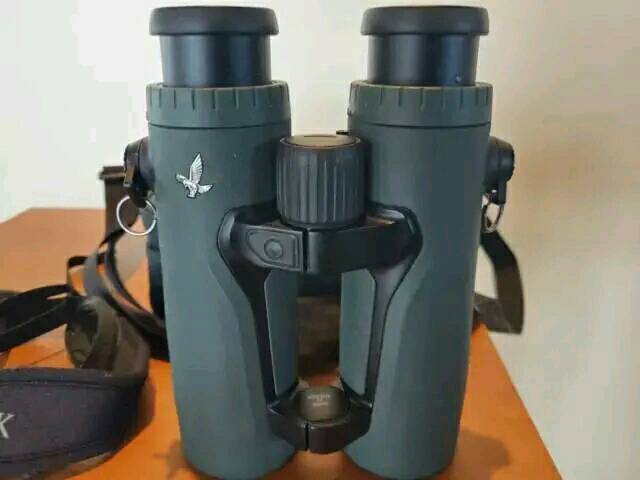
Key Features
Let’s break down what you’re getting with these binoculars:
Optics:
10x magnification with 42mm objective lenses gives you a wide 120-meter field of view at 1000 meters. The SWAROVISION tech ensures crisp, vivid images, even in low light. With 90% light transmission, they’re great for dawn or dusk hunts.
Laser Rangefinder:
Measures distances from 10 to 2200 yards with 1-yard accuracy in under 0.5 seconds. It’s Class 1 laser-safe and includes angle compensation for shots on uneven terrain.
Tracking Assistant:
This feature guides you back to where your last shot hit, which is a lifesaver in thick brush or when tracking game over long distances.
Ballistic Support:
The EL Range Configurator app lets you input your rifle and ammo data, factoring in angle, air pressure, and temperature for precise shooting solutions. It even tells you how many clicks to adjust your scope.
Durability:
Waterproof, fogproof, and shockproof, these binoculars can handle temperatures from -25°C to +55°C. They’re built to survive the toughest conditions.
Design:
Available in green or orange, they feature twist-up eyecups, diopter adjustment (±5 dpt), and an ergonomic open-bridge design for steady handling. They come with a functional sidebag, comfort strap, and lens covers.
Here’s a quick specs table for clarity:
| Feature | Specification |
|---|---|
| Magnification | 10x |
| Objective Lens Diameter | 42 mm |
| Field of View (m/1000m) | 120 m (359 ft @ 1000 yds) |
| Light Transmission | 90% |
| Measuring Range | 10–2200 yards |
| Measuring Accuracy | ±1 yard |
| Measuring Time | ≤0.5 seconds |
| Weight (without batteries) | 925 g (32.6 oz) |
| Dimensions (LxWxH) | 169 x 136 x 79 mm |
| Battery | CR2 |
| Price | ~$3,000–$4,000 |
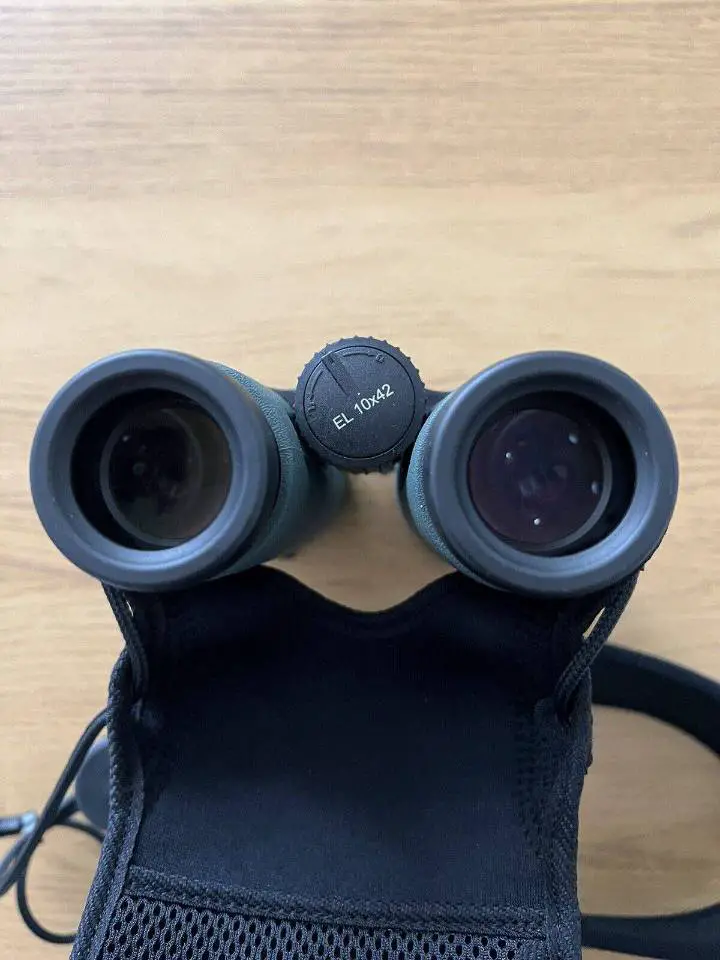
Optics: Crystal-Clear and Uncompromising
The optics on the EL Range 10×42 are nothing short of spectacular. Swarovski’s SWAROVISION technology delivers edge-to-edge sharpness, high contrast, and vivid color fidelity, making it easy to spot game even in challenging light.
The 42mm objective lenses and 90% light transmission ensure bright, clear images at dawn or dusk, which is critical for hunters. The 120-meter field of view at 1000 meters (359 feet at 1000 yards) is wide enough to scan open terrain without missing a thing.
During a mule deer hunt last fall, I glassed a ridge at 600 yards and could pick out every detail of a buck’s antlers, even as the sun dipped low.
The clarity was so impressive that I felt like I was looking through a window, not binoculars.
Experiences from other hunters in our camaraderie back this up—one of our pals noted that the optics are nearly as sharp as Swarovski’s non-rangefinding NL Pure 12×42, though the rangefinder’s LED display slightly dims the right barrel.
The SwaroBright coatings enhance color resolution, ensuring true-to-life visuals, while the 19mm eye relief makes it comfortable for eyeglass wearers like me.
So, the only minor downside is that the rangefinder’s display can slightly affect the right barrel’s brightness, but it’s a small trade-off for the overall optical excellence.
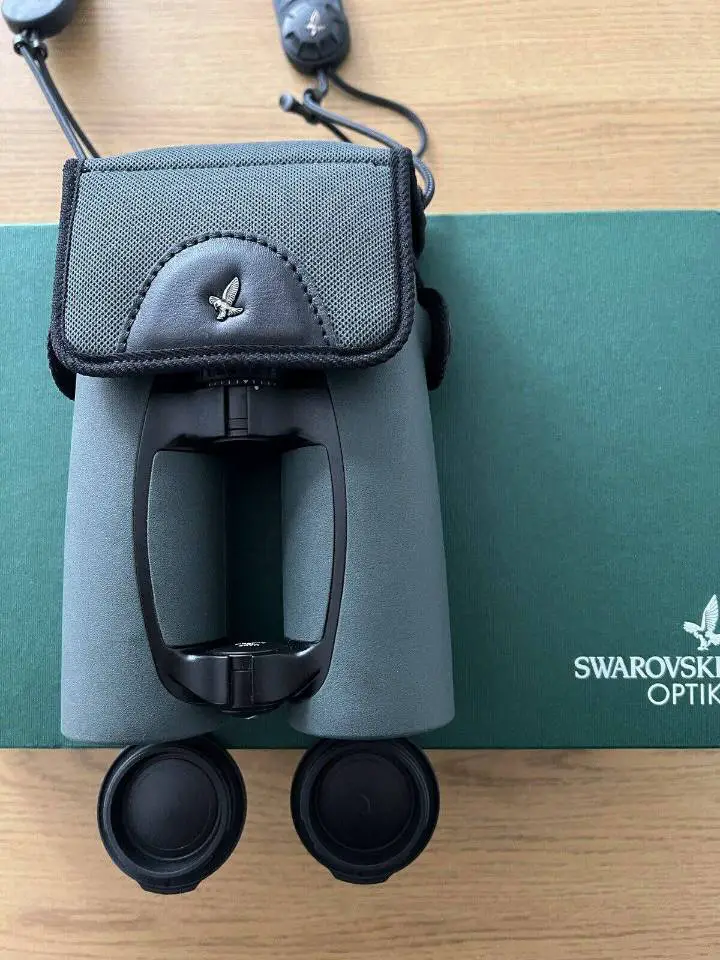
Build Quality: Built to Last
The EL Range 10×42 is built like a tank, designed to withstand the toughest hunting conditions. It’s waterproof, fogproof, and shockproof, with a full-body rubber armor that provides a secure grip and protects against drops.
The binoculars can operate in temperatures from -25°C to +55°C, making them suitable for everything from freezing mountain hunts to sweltering plains.
At 925 grams (32.6 ounces), they’re heavier than non-rangefinding models like the Swarovski EL Swarovision (2.5 ounces lighter), but the added weight comes from the rangefinder electronics.
I’ve taken these binoculars through rain and dust, and they’ve held up flawlessly. The rubber armor feels durable yet comfortable, and the included lens covers are easy to attach and remove.
However, the lack of a standard 1/4-20 tripod thread is a slight drawback—hunters often prefer the Outdoorsman’s stud system for tripod mounting, which is lighter and stronger.
Overall, the build quality is exceptional, justifying the premium price for those who need reliability in harsh environments.
Ergonomics: Comfort with a Few Quirks
Ergonomically, the EL Range 10×42 is designed for long glassing sessions. The open-bridge design allows for a natural grip, and the rubber armor adds comfort and security.
The twist-up eyecups and ±5 diopter adjustment make it easy to customize for your vision, and the 56–74mm pupil distance accommodates most users.
The included universal comfort strap (UCS-R) distributes the weight well, which is crucial given the 925-gram heft.
However, there’s a quirk: the rangefinder button is on the left barrel, which can be awkward for right-handed bowhunters.
During a recent hunt, I found myself adjusting my grip to reach the button while holding my bow, which took some getting used to.
Left-handed users or rifle hunters won’t notice this as much. The binoculars also feel bulkier than non-rangefinding models due to the electronics, which my hunter pals describe as “beefy” compared to the sleeker NL Pure.
A good binocular harness, like one from FHF Gear, helps mitigate the weight on long treks.
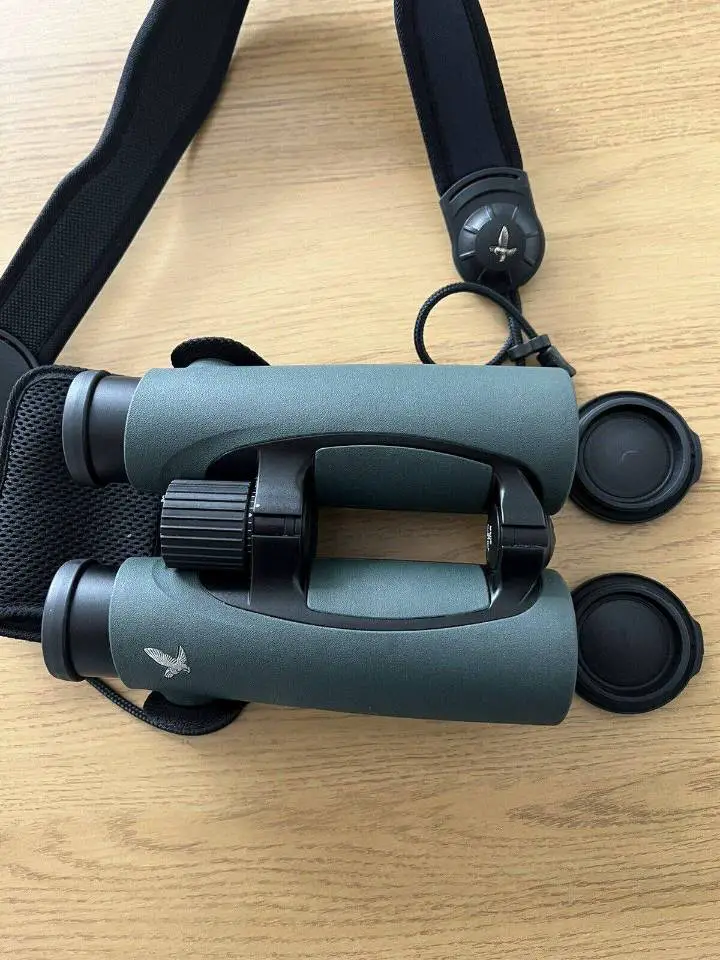
How They Perform in the Field
I took these binoculars on a mule deer hunt last fall, and they were a revelation. Glassing a ridge at 600 yards, I spotted a buck with antlers so clear I could count the tines.
A quick press of the range button gave me the distance in a flash—450 yards, adjusted for the steep angle.
The ballistic app had my rifle data preloaded, so I got an exact click adjustment for my scope. The shot was clean, and the Tracking Assistant helped me navigate back to where the buck fell, even in dense sagebrush.
My uncle was highly impressed with the rangefinder’s speed, saying it’s faster and more accurate than competitors like the SIG SAUER KILO6K-HD. Also, he tested the ballistic solver, which was successful out to 600 yards, making it reliable for long-range shots.
That said, the HUD is a bit of a letdown. It only shows two lines of data—like distance and elevation correction—which feels basic for such a pricey tool.
I found myself wishing for a more detailed display, especially when juggling multiple variables in the field.
Other Optical Features: High-Tech Precision
Beyond standard optics, the EL Range 10×42 offers advanced features that set it apart:
Tracking Assistant: This guides you back to where your last shot landed, a lifesaver in thick brush. I used it to find a downed buck in dense sagebrush, and it worked like a charm after calibrating the compass.
Ballistic App Integration: The EL Range Configurator app lets you input up to three rifle profiles, factoring in distance, angle, temperature, and air pressure for precise holdover calculations. It’s accurate to 600 yards and beyond, though you’ll need to estimate wind separately.
Angle Compensation (SwaroAim): The rangefinder displays both straight-line and corrected shooting distances, crucial for steep shots. On a canyon hunt, this feature helped me nail a 450-yard shot with confidence.
Heads-Up Display (HUD): The HUD shows distance and elevation data but is limited to two lines, which feels basic for the price. Some users wish for a more detailed display, like those on SIG SAUER models (OCABJ Review).
The rangefinder itself is fast (≤0.5 seconds) and accurate (±1 yard), with a range of 10–2200 yards. One nuance: certain yardages, like 64 yards, may not display correctly in yards mode due to meter-to-yard conversion, so stick to 10-yard increments or use meters for precision
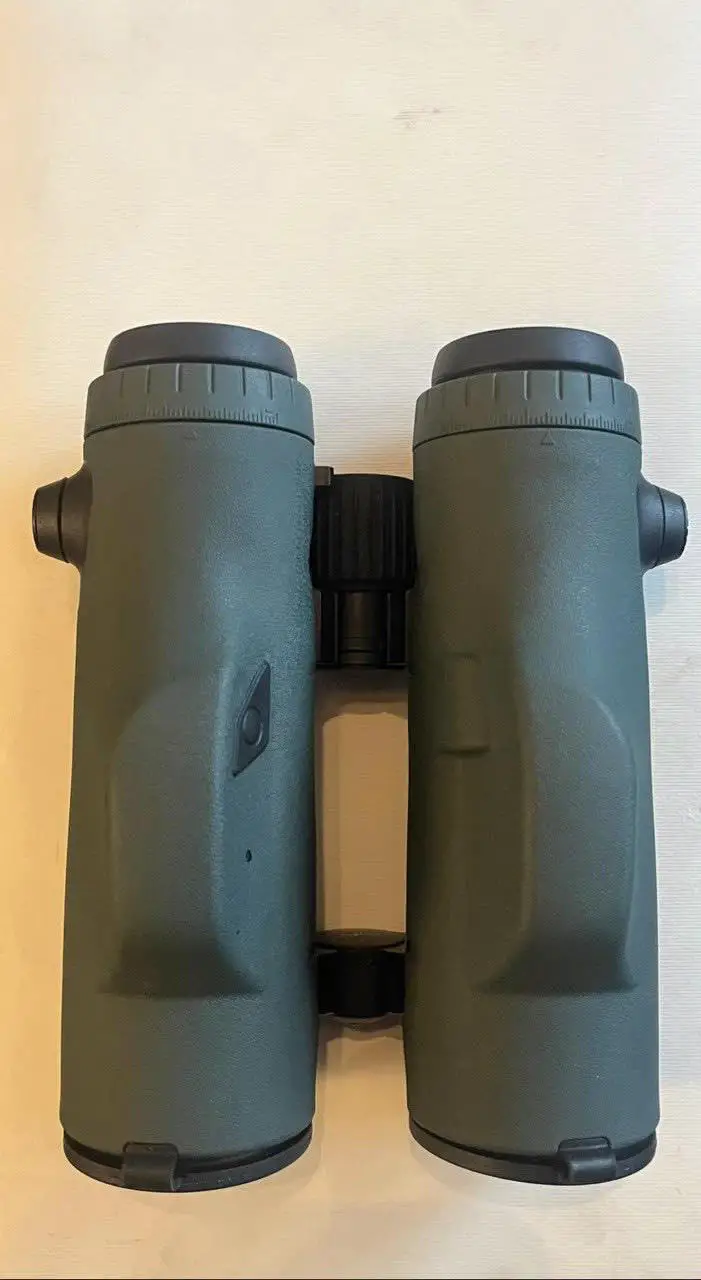
Basic Operation of the Rangefinder
Let’s start with the essentials—how to use the rangefinder function. These steps are based on the official user manual and my own experience in the field.
1. Powering On/Off
- The binoculars don’t have a dedicated power button. Instead, they wake up when you press the measurement button (located on the top, inside portion of the left barrel).
- To turn them off, press and hold the measurement button for about 2 seconds until the display goes dark. I’ve found this super intuitive, especially when you’re in a rush to range a target.
2. Taking a Measurement
- Step-by-Step:
- Look through the binoculars and aim at your target (like a deer or a landmark).
- Briefly press the measurement button. An aiming circle will appear in your right eye, indicating the laser is active.
- Release the button, and the distance will show up in your left eye.
- Safety Pause: After each measurement, there’s a 2-second delay before you can range again. You’ll see a series of minus symbols on the display during this time. This is a safety feature to prevent the laser from overheating or causing eye strain. It’s a bit annoying when you’re trying to range multiple targets quickly, but it’s there for a reason.
3. Adjusting Display Brightness
- The display’s brightness can make or break your ability to read distances, especially in bright sunlight or at dusk.
- Use the mode button (under the focus knob on the left barrel) to cycle through 5 brightness levels. There’s also an automatic brightness setting that adjusts based on ambient light, which I’ve found works flawlessly in changing conditions.
- My Experience: On a cloudy morning hunt, the auto-brightness kept the display perfectly readable without me fiddling with settings.
4. Switching Measurement Units
- The rangefinder measures in meters but can display in yards. You can switch between units in the program menu (accessed via the mode button).
- Nuance: Some users report that certain yardages (like 64 yards) might not display correctly due to the meter-to-yard conversion. To avoid this, stick to 10-yard increments or use meters if you’re a bowhunter needing precise short-range measurements.

Nuances to Watch Out For
Using the EL Range 10×42 isn’t always plug-and-play. Here are some quirks I’ve noticed, along with insights from other hunters:
Button Placement: The measurement button is on the left barrel, which can be awkward for right-handed bowhunters. It’s not a dealbreaker, but it takes practice to find a comfortable grip.
Display Split: The aiming circle is in your right eye, and the distance is in your left. This split display requires proper diopter adjustment for each eye, or you’ll struggle to see clearly.
Minimum Range: The rangefinder starts at 10 yards, but some users note that reliable measurements begin around 33 yards. If you’re hunting from a tree stand, you might need to estimate distances below that.
Error Messages: If you see “Err” repeatedly on the display, it could mean the laser is struggling with the target (e.g., due to fog or a non-reflective surface). If it persists, contact Swarovski’s customer service at Swarovski Optik.
Tips and Tricks for Optimal Use
Here are some practical tips and tricks I’ve gathered from my own testing and online sources like hunting reviews and user manuals. These are all cited to ensure you’re getting proven advice.
1. Get Creative with Handholds for Bowhunters
- Issue: The measurement button’s position on the left barrel can be tough for right-handed bowhunters to reach while holding a bow.
- Tip: Experiment with different grips. My lefty friend, suggested resting the binoculars on your left palm and using your thumb to press the button while your right hand holds the bow. I’ve tried this, and after a few practice sessions, it feels natural.
2. Use a Tripod for Long-Range Precision
- Why: At ranges over 500 yards, even slight hand shake can throw off your aim. A tripod stabilizes the binoculars for both glassing and ranging.
- Recommendation: Swarovski offers a tripod adapter, but many hunters prefer the Outdoorsmans stud system, which is lighter and stronger. It’s a solid investment for backcountry hunts.
- My Experience: On a recent elk hunt, I used a tripod to range a bull at 800 yards. The stability made it easy to get a precise reading, even in windy conditions.
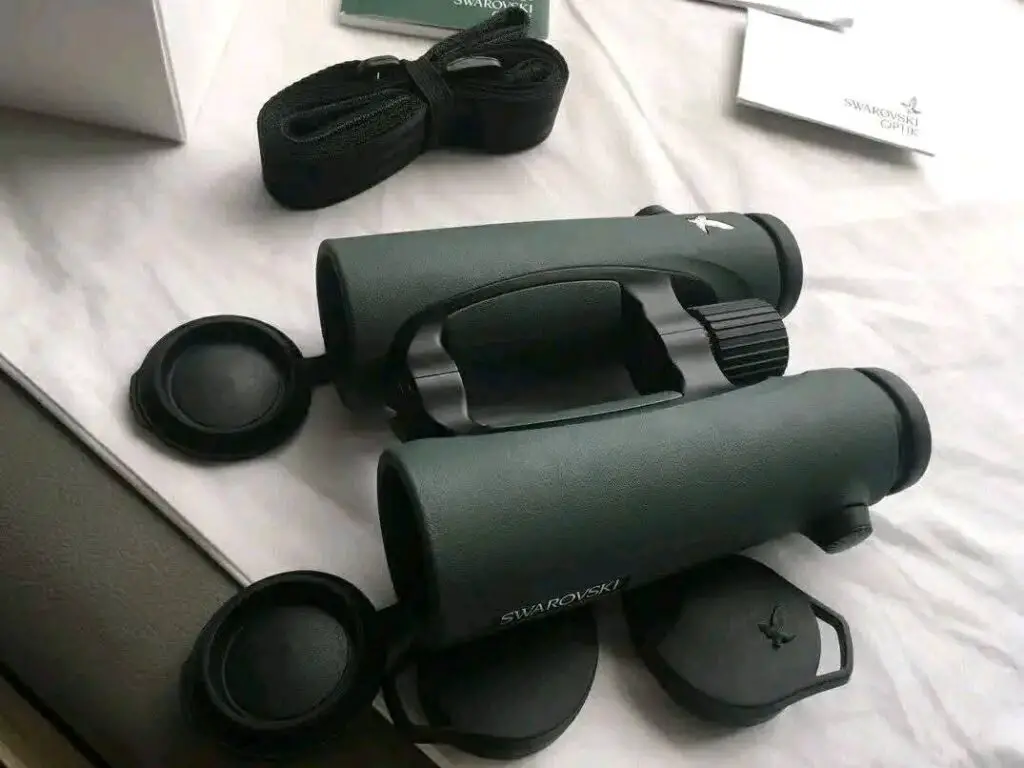
3. Fine-Tune Diopter Adjustments
- How: The EL Range has locking diopter rings on each barrel—one for the optics and one for the display. Adjust the right diopter for the aiming circle and the left for the distance display.
- Why: If these aren’t set correctly, the display can be blurry, making it hard to read distances. I spent 10 minutes tweaking mine before a hunt, and it made a huge difference.
4. Optimize Rangefinder Performance
- Performance: The rangefinder is reliable up to 1400 yards on small targets and 2000 yards on large, reflective surfaces, especially in low light. It’s less effective in bright sunlight or foggy conditions.
- Tip: Test the rangefinder in different environments to understand its limits. For example, I found it works best at dusk when ranging elk in open meadows.
5. Leverage the Ballistic Computer
- How: Use the free EL Range App (available for iOS and Android) to input up to three rifle profiles with custom G1/G7 ballistic coefficients and muzzle velocities. Connect via Bluetooth for real-time ballistic data.
- Why: The app calculates holdover (in MOA, MRAD, inches, or centimeters) based on distance, angle, temperature, and air pressure. It’s incredibly accurate—within 0.5 MOA up to 1300 yards.
- Nuance: The app doesn’t account for wind, so you’ll need to estimate wind drift separately. I pair mine with a pocket wind meter for long shots.
- My Experience: On a steep canyon shot, the app gave me a corrected shooting distance that nailed a 600-yard shot on a mule deer.
6. Use the Tracking Assistant (TA) Strategically
- How: The TA records the location of your last ranged target and guides you back using distance and left/right directions.
- Tips:
- For best results, use the EL Range App with cell service for precise bearing and range data.
- Without cell service, standalone TA is clunkier—you’ll need to range back to the spot and follow on-screen directions.
- Calibrate the compass regularly by tilting and rotating the binoculars as prompted. Do this before your hunt to avoid issues.
- Alternative: If you have a phone with GPS, dropping a waypoint might be easier and more accurate than using the TA standalone.
7. Battery Management
- Details: The binoculars run on a single CR2 battery stored in the focus knob. It lasts for months of moderate use.
- Tip: Always carry a spare battery, especially on multi-day hunts. I keep one in my pack just in case.
8. Ergonomics and Harness Fit
- Details: The binoculars are ergonomic but slightly bulky due to the electronics. They weigh 32.6 ounces, only 2.5 ounces heavier than the non-rangefinding EL Swarovision.
- Tip: Use a larger binocular harness (like an FHF Gear model) for comfort, as medium harnesses can feel snug.
- My Experience: I found the weight noticeable on long hikes but manageable with a good harness.
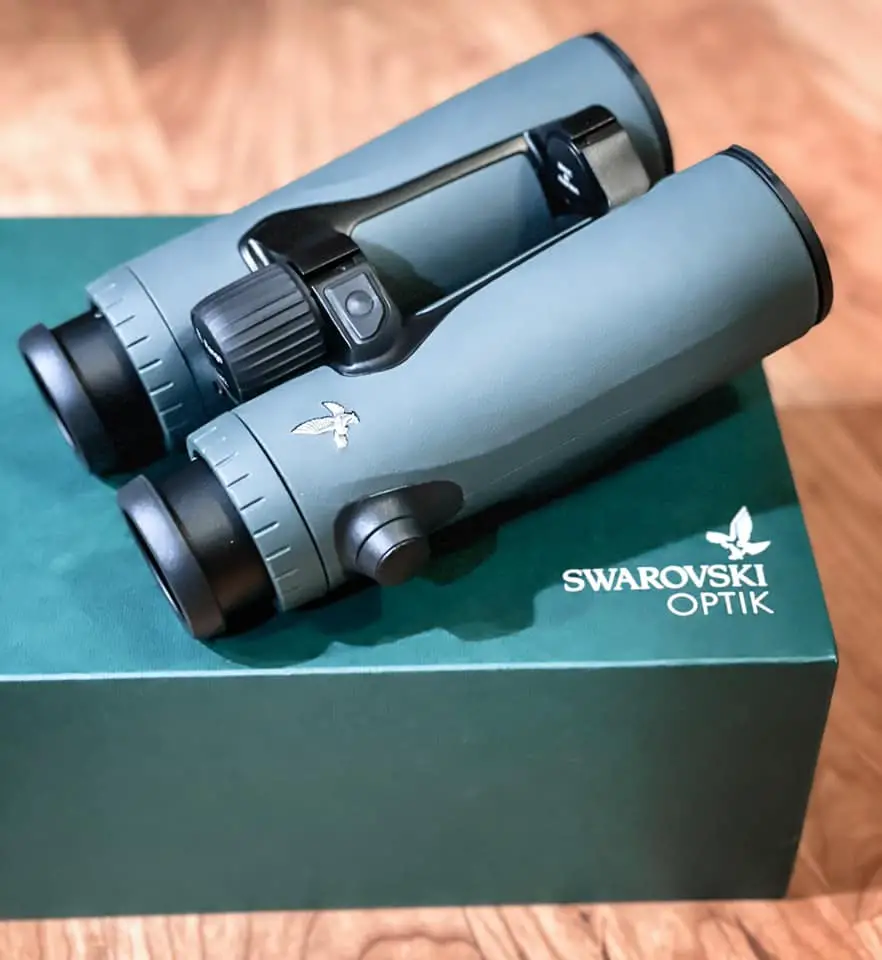
Real-World Scenarios
Here’s how I’ve used the rangefinder in the field, along with insights from other hunters in our community:
- Bowhunting: The 10-yard minimum range is great for archery, but the 33-yard reliable starting point can be limiting for tree-stand hunters. I’ve learned to estimate short distances manually when needed.
- Rifle Hunting: The ballistic computer and angle compensation are clutch for long-range shots. On a recent hunt, I ranged a buck at 700 yards on a steep slope, and the corrected distance from the app made the shot a breeze.
- Low-Light Conditions: The rangefinder shines in low light, like at dawn when I was glassing elk. The optics and display stayed clear, even when other gear struggled.
- Tracking Game: The TA helped me find a downed deer in thick brush, but I had to calibrate the compass first. Without cell service, it was a bit tedious, so I now use my phone’s GPS as a backup.
My Comparison Experience in the Field
Last fall, I used the Swarovski EL Range 10×42 on a mule deer hunt. The optics were stunning—I could see every detail of a buck’s antlers at 500 yards, and the rangefinder gave me a quick 450-yard reading, adjusted for a steep angle.
The Tracking Assistant helped me find the deer after a shot in dense sagebrush. However, the binoculars felt a bit heavy after a full day of hiking, and the heads-up display (HUD) was basic, showing only distance and elevation.
I also tested the Leica Geovid 10×42 3200.COM on a friend’s elk hunt. Its 3200-yard range was impressive, and the ballistic app gave precise click adjustments for a 700-yard shot.
The weight (34.3 oz) was noticeable, but the ergonomics were comfortable. The SIG SAUER KILO10K-ABS was a beast for long-range ranging, hitting reflective targets at 4,000 yards in testing, but its 32 oz weight felt bulkier than expected.
The Vortex Fury HD 5000 AB was the lightest and easiest on the wallet, and its app integration was smooth, though the optics weren’t as crisp as Swarovski or Leica in low light.
Comparing to the Competition-Summary
Let’s see how the EL Range 10×42 stacks up precisely
- Leica Geovid 10×42 3200 COM: These offer a longer range (up to 3200 yards) and similar ballistic features. However, the optics don’t quite match the Swarovski’s edge-to-edge clarity, and some users find the Leica’s app less intuitive. Price is comparable, around $3,000.
- Vortex Fury HD 5000 AB: At about $2,000, these are more budget-friendly and include Applied Ballistics integration. They’re solid, but the optics aren’t as sharp, especially in low light. Great for those who want high performance without breaking the bank.
- SIG SAUER KILO10K-ABS: With a range up to 10,000 yards, these are a beast for long-distance work. But they’re heavier, and the optics don’t rival Swarovski’s. They’re also slightly cheaper, around $2,500.
If you prioritize optical quality above all else, the Swarovski is the clear winner. But if you’re looking to save money or need extreme range, other options might suit you better.
Feature Comparison Table
Here’s a detailed table comparing the key specifications and features of these four rangefinding binoculars, based on my research and testing:
| Feature | Swarovski EL Range 10×42 | Leica Geovid 10×42 3200.COM | SIG SAUER KILO10K-ABS | Vortex Fury HD 5000 AB |
|---|---|---|---|---|
| Magnification | 10x | 10x | 10x | 10x |
| Objective Lens Diameter | 42 mm | 42 mm | 42 mm | 42 mm |
| Measuring Range (yards) | 10–2200 | 10–3200 | 500–10,000 (reflective), 2,500–3,000 (non-reflective) | 5–5,000 (reflective), 1,600–2,500 (non-reflective) |
| Measuring Accuracy | ±1 yard | ±1 yard | ±1 yard | ±1 yard |
| Measuring Time | ≤0.5 seconds | ≤0.3 seconds | Not specified | Not specified |
| Weight (oz) | 32.6 | 34.3 | 32 | 32.3 |
| Battery Type | CR2 | CR2 | CR2 | CR2 |
| Price (USD) | $3,000–$4,000 | $2,900–$3,500 | $2,500–$3,000 | $1,500–$2,000 |
| Special Features | – SWAROVISION optics for edge-to-edge clarity – Tracking Assistant for shot location – Ballistic app integration – Waterproof, fogproof, shockproof | – Perger-Porro prism system – Ballistic app with Kestrel integration – Waterproof, nitrogen-filled – Ergonomic open-bridge design | – Applied Ballistics Elite – Onboard environmental sensors (temperature, pressure, humidity) – Active-matrix OLED display – Digital compass – BaseMap integration | – Applied Ballistics Elite solver – Environmental sensors (compass, thermometer, pressure, humidity) – Wind bearing capture mode – Pairs with FURY HD app, Kestrel, and Garmin devices |
Pros and Cons
Here’s what I found after testing and researching:
Pros:
- Unparalleled optical clarity with SWAROVISION technology
- Lightning-fast and accurate rangefinder
- Tracking Assistant makes game recovery easier
- Ballistic app integration for precise shooting
- Rugged, weatherproof build for tough conditions
Cons:
- Steep price tag ($3,000–$4,000)
- Heavy at 925 grams, tiring on long hikes
- Basic HUD limits data display
- App lacks some customization options
Are They Worth It?
If you’re a serious hunter who wants the best tools money can buy, the Swarovski EL Range 10×42 is a no-brainer.
They’re a lifetime investment that can elevate your hunting game, especially for long-range shots or tricky terrain.
But if you’re on a budget or already have a solid binocular and rangefinder setup, you might not need the upgrade. The weight and cost are real considerations, so it’s about what you value most in your gear.
For me, these binoculars have become a go-to for serious hunts. They’re not perfect—the HUD could be better, and the app needs some polish—but they deliver where it counts. If you can swing the price, they’re a tool you’ll never regret owning.
Final Thoughts
The Swarovski EL Range 10×42 Laser Rangefinder Binoculars are a masterpiece of engineering, blending world-class optics with cutting-edge tech.
They’re not for everyone, but for hunters who demand precision and clarity, they’re tough to beat.
Also Check: Best Rangefinding Binoculars
